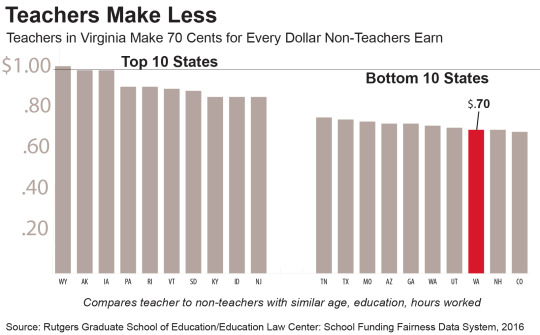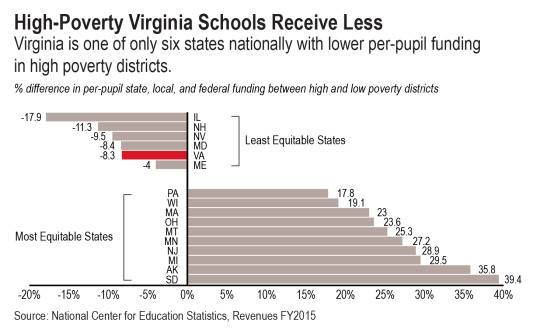December 14, 2018
Governor Northam Sets the Stage for Improving K-12 Investments
This week Governor Northam announced a series of investments in Virginia’s public schools that he will include in his amendments to the state’s 2018-2020 budget. These proposals include improving teacher pay, increasing the number of counselors in schools, offering more services and supports for students from low-income families, and increasing state aid for improving school facilities. This budget proposal offers a glimpse of the Virginia that we can become when we choose to invest available resources in our schools and communities.
The salary increase for teachers and school staff lifts an initially budgeted 3 percent pay increase up to a 5 percent increase. This takes a step to repair the inadequate compensation provided to Virginia’s teachers that trails the national average by more than 14 percent or $8,500 a year and is lower than nearby states like Pennsylvania, Maryland, Georgia, and Kentucky. Virginia’s teacher salaries fare even worse when compared to the private sector, where teachers make 30 percent less than other occupations with similar age, degree level, and hours worked. It should come as no surprise that we have a teacher shortage in Virginia with more than 1,000 unfilled vacancies, given how poorly teachers are compensated for the important work that they do.

The governor has also called for increasing Virginia’s At-Risk Add-On program by $35 million. Virginia is one of just six states in the nation where school districts with the least poverty receive more funding per student (state, local, and federal combined) than the districts with the highest poverty rates. That’s why we see Virginia getting an “F” on a national report card for the fairness of K-12 funding distribution. It’s largely Virginia’s Black and Latinx students that are being deprived of the opportunity to pursue their goals and career ambitions. That’s because students of color are extremely over-represented in high poverty schools. Students of color represent just over half of the student population statewide, yet account for more than 80 percent of the students in high poverty schools. Increasing this targeted funding will give schools additional resources for dropout prevention,, specialized instruction for students, post-secondary access programs, and to help hard-to-staff schools recruit and retain teachers.

The proposal to increase school counselors would begin a three year ramp up to reach the recommended caseload of having at least one counselor for every 250 students by 2022. The average student caseload for school counselors has grown from 300 to 385 students over the past decade, with the caseloads in some schools reaching more than 1,000 students per counselor.That number is well above recommended standards, and our average caseload exceeds many of our neighboring states, including West Virginia, North Carolina, Maryland, and Tennessee. Schools with lower student caseloads for counselors have better graduation rates, higher attendance, and fewer disciplinary incidents than schools with higher case loads, especially in high-poverty schools.
Make no mistake, these proposals do not fix the problems described above. A 5 percent pay increase for teachers does not get us to the national average and a $35 million increase for at-risk funding distributed across 132 school divisions does not solve the inequity in our school funding system. Yet, they do illustrate what we can start to accomplish when we prioritize our schools, teachers, and students above tax giveaways and start modernizing our tax system.
If we are going to fully address the challenges of teacher pay, school funding in high-poverty communities, and shortages of counselors and support staff in our schools, then we have to go further. Virginia has the 12th highest per capita income in the nation, yet the state spends the 11th least per student in our K-12 schools. The top income tax bracket in the state begins at $17,001 meaning that people making millions in annual income are paying the same top state income tax rate as families struggling to get by. So long as Virginia is 48th in the revenues our state and local governments are collecting relative to personal income, then these funding challenges will remain for schools.
Still, Governor’s Northam’s investments shine a light on the path we should continue to follow to modernize our tax system and adequately fund our schools.
Category:
Education
